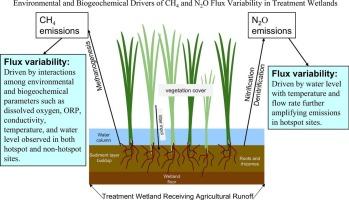Environmental and biogeochemical drivers of CH4 and N2O flux variability in treatment wetlands
IF 4.1
2区 环境科学与生态学
Q1 ECOLOGY
引用次数: 0
Abstract
Methane (CH4) and nitrous oxide (N2O) emissions from wetlands vary spatially, influencing total greenhouse gas (GHG) fluxes. Accurately quantifying these variations is essential for refining CH4 and N2O budgets and developing effective mitigation strategies. This study applies the closed chamber method to assess CH4 and N2O flux variability over five years in treatment wetlands designed to reduce agricultural diffuse pollution, focusing on key environmental and biogeochemical drivers at 12 sampling points. Hotspots, identified as sampling points where high-emission events (hot moments) contributed disproportionately, exceeding 8.33 % of total emissions, were determined from the mean plus two-standard-deviation threshold. Median (interquartile range) CH4 emissions were 115.86 (16.1–1191.31) μg CH4-C m−2 h−1 in hotspots and 109.15 (27.49–722.62) μg CH4-C m−2 h−1 in non-hotspots. Similarly, median N2O emissions were 75.33 (29.71–187.85) μg N2O-N m−2 h−1 in hotspots, compared to 15.41 (5.87–38.01) μg N2O-N m−2 h−1 in non-hotspots. Statistical analysis identified water level as the key predictor of N2O flux differences, with lower water levels driving higher emissions. CH4 fluxes were influenced by multiple interacting factors, including dissolved oxygen, oxidation-reduction potential, conductivity, and water level, with the highest emissions under more reducing conditions. Seasonal trends revealed higher CH4 and N2O fluxes during the growing season, coinciding with higher temperatures and reduced flow rates. Our findings highlight the critical role of water level regulation, flow rate control, and oxygenation strategies in reducing CH4 and N2O emissions. These insights contribute to optimizing wetland design and management for water treatment efficiency and climate mitigation.

处理湿地CH4和N2O通量变异的环境和生物地球化学驱动因素
湿地的甲烷(CH4)和氧化亚氮(N2O)排放存在空间差异,影响温室气体(GHG)总通量。准确量化这些变化对于完善CH4和N2O预算和制定有效的减缓战略至关重要。本研究采用封闭室方法评估了旨在减少农业扩散污染的处理湿地5年来CH4和N2O通量的变化,重点关注了12个采样点的关键环境和生物地球化学驱动因素。热点被确定为高排放事件(热时刻)不成比例贡献的采样点,超过总排放量的8.33%,由平均值加两个标准偏差阈值确定。热点地区CH4排放中位数为115.86 (16.1 ~ 1191.31)μg CH4- c m−2 h−1,非热点地区CH4排放中位数为109.15 (27.49 ~ 722.62)μg CH4- c m−2 h−1。同样,热点地区N2O排放中值为75.33 (29.71 ~ 187.85)μg N2O- n m−2 h−1,非热点地区为15.41 (5.87 ~ 38.01)μg N2O- n m−2 h−1。统计分析表明,水位是N2O通量差异的关键预测因子,水位越低,排放越高。CH4通量受溶解氧、氧化还原电位、电导率和水位等多种相互作用因素的影响,还原条件越强,CH4排放量越大。季节趋势显示生长季CH4和N2O通量较高,与温度升高和流速降低相一致。我们的研究结果强调了水位调节、流量控制和氧化策略在减少CH4和N2O排放中的关键作用。这些见解有助于优化湿地设计和管理,以提高水处理效率和减缓气候变化。
本文章由计算机程序翻译,如有差异,请以英文原文为准。
求助全文
约1分钟内获得全文
求助全文
来源期刊

Ecological Engineering
环境科学-工程:环境
CiteScore
8.00
自引率
5.30%
发文量
293
审稿时长
57 days
期刊介绍:
Ecological engineering has been defined as the design of ecosystems for the mutual benefit of humans and nature. The journal is meant for ecologists who, because of their research interests or occupation, are involved in designing, monitoring, or restoring ecosystems, and can serve as a bridge between ecologists and engineers.
Specific topics covered in the journal include: habitat reconstruction; ecotechnology; synthetic ecology; bioengineering; restoration ecology; ecology conservation; ecosystem rehabilitation; stream and river restoration; reclamation ecology; non-renewable resource conservation. Descriptions of specific applications of ecological engineering are acceptable only when situated within context of adding novelty to current research and emphasizing ecosystem restoration. We do not accept purely descriptive reports on ecosystem structures (such as vegetation surveys), purely physical assessment of materials that can be used for ecological restoration, small-model studies carried out in the laboratory or greenhouse with artificial (waste)water or crop studies, or case studies on conventional wastewater treatment and eutrophication that do not offer an ecosystem restoration approach within the paper.
 求助内容:
求助内容: 应助结果提醒方式:
应助结果提醒方式:


